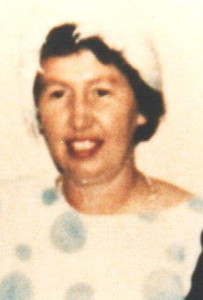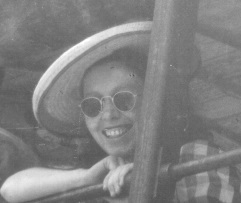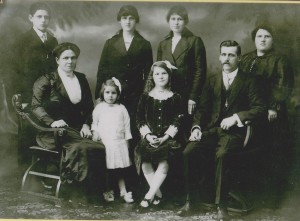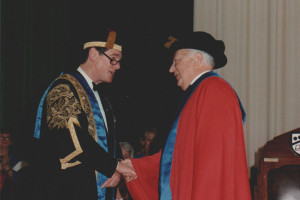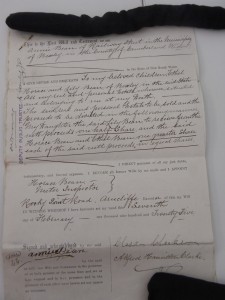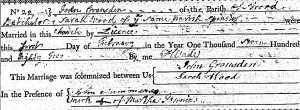Over the years I have been searching for the death of Mary Ann Russell nee Gransden and her husband William Russell. To date I have not been able to find them. The records that I do have for them seem to end in the mid to late 1860’s for both parents, although I still have some records to get which may shed some light on how long William Russell at least lived.
In the death records of their children, that I have, William is named as father but often Mary Ann is not named or known. This may indicate that the person who was giving information simply did not know it or it may indicate a bunch of other possibilities including desertion of her husband by Mary Ann, an early death etc.
One of the possibilities was an early death for whatever reason. In particular 1867 is a possibility. In this year there was a large flood across the majority of NSW, plus an extremely cold winter. A lot of people lost their lives and not all of those would have been recorded.
One eye witness account of the loss of life in those floods is included below as it was in the Bathurst Newspaper of the day. Mary and William were known to live around the Bathurst area. The family in this story were closer to Dubbo than Bathurst but deaths and problems with the rising river were happening all over NSW at this time with some quite significant flood events happening at Bathurst and the immediate surrounds.
THE FLOODS.
DISASTROUS FLOOD AT BURRANDONGLoss of Life(The Bathurst Times)Mr. W. H. Suttor has handed us the following letter,written by his son Mr F.B. Suttor, from Burrandong,dated 23rd June. The tale it tells adds another appallingincident in the many gloomy disasters which have attendedthe recent inundation and the appeal it makes to benevo-lence, we are sure, it will not be addressed in vain. MrSuttor says: –I am writing a few lines hoping that the river will below enough in the morning for the boats to work, so thatI may send this to the post. We had a most disastrousflood, though we have not lost much-a hut and some fenc-ing being all. The water was in some of the outbuild-ings, but fortunately, did not reach the house. Three feetmore would have turned us out. We had everything readyto move, and remained up all Friday night and a mostanxious night it was. The river, however began to fallabout daylight.I have now to tell of a most heartrending calamity.The hut of a shepherd of Mr Blunden, named Baker,who lived near the junction of the Mudgee River got sur-rounded before he and his family could move (the waterrising six feet in ten minutes, and out of eleven personsall were drowned but three. Those saved are the oldest boyand girl and father. Those drowned are the mother, fiveboys, a baby (girl), and a married man named Smith, whocame to help them about dusk, just before the sudden riseof water. At the first rush of the flood, they all got on tothe tables, then onto a loft, and then had to cut a hole inthe back and get on to the top of the roof . Here they re-mained until the water reached their mouths, when the fourleft alive swam to a tree. Smith not being able to swim,sank as soon as he left the hut. The poor old father(Baker) gives a most distressing account of the scene- howhe held his children in his arms, dropping them as theydied (of the cold he says) to take up others that were aliveuntil none were left. He says the dogs, cats, and fowlskept swimming round them and jumping on them all thetime they were on the hut.“The survivors were rescued about daylight by the bravewife of the man Smith who pulled a boat about a mile tothe hut, and then took them to the shore. She heardthem cooeying for a long time, and started to try and savethem, which she had great trouble to effect, the current wasso strong”‘The following particulars of the melancholy catastrophehave been kindly furnished by Mr F. B. Suttor, who helda magisterial inquiry into the matter –Isaac Daniel Baker recognised the bodies as those of hiswife Mary Ann, aged about 43 years; of his seven children,varying in age from 8 months to 13 years; and of Frede-rick Smith. He deposed; “I am a shepherd in the employof Messrs Blunden, and live near the junction of theMudgee and Macquarie Rivers; on the 21st, when thesheep came home, about 5 o’clock p.m., I went to the bankof the Macquarie, to see how the river was, I saw it wasrising; there was some high ground at the back of thesheepyard, where I had made a gateway to let the sheepout in case of a flood, this was between my hut and theriver; we put in the sheep and I went in to supper withall my family; I told my eldest son Moses we would haveto remain up all night to watch the flood, after we hadsupper my two children who are now alive, went to seethe flood and returned and told me that the water wascoming very fast down the gully, and was within two orthree hundred yards from the hut; when I went out,the deceased, Frederick Smith, was coming towardsthe hut to render me assistance, he said the waterhad risen six feet in the Mudgee River while hewas at supper, and asked me what I was going to do; Isaid we shall get the children out; we went to the hut,and I told my wife to get the] children ready, as the waterwas coming round us fast but there was still dry ground;in about ten minutes from that time when I went out againI found that the water had entirely surrounded us, andthere was no possibility of escape; we then all went intothe hut, I fastened the door and about twenty minutesafterwards the water began to come in; I then put my wifeand children on the loft over the bedroom, andstood on the table; I was not afraid, as I hadhopes that the water would not rise much higher;at this time Frederick Smith was sitting on one of thebeams of the loft; when the water reached thetable I got off and sat on another beam, in about threequarters of an hour the water rose to the top of the wallplate, I then got a tomahawk and cut a hole in the barkof the roof, the deceased Frederick Smith got out first,I handed the children out to him, and the rest followed,when I got out the moon had just risen, and there was noland to be seen; I then cooeyd for the first time, it beingthen about 9p.m.; we were all cooeying, and in aboutthree quarters of an hour heard a voice in the distance andthought it was from Mrs Smith, wife of the deceased F.Smith, they lived on the Mudgee River, about a third of amile from my hut; the water at this time about ten feetabove the floor of the hut, a short time after this, I heardMrs Smith call out and ask if Fred (her husband) wasall right; I called loudly for help, and told her to go to MrBlunden’s for the boat; we thought she understood us, andher husband told us not to shout any more as it mightbother her; some time after, as the water still rose fast, Icooeyed again, and she anwered. I then felt sure she hadnot gone to Blunden’s; when the water reached theridge pole on which we were sitting, seeingno possibility of escape I told the childrento pray; we all joined in prayer; we were allcomposed but one ltttle boy, who was crying; the watercontinued to rise, and we had to stand on the ridge-pole,about half-past 3 in the morning the first of the childrendied-Fredenck, seven years old the water then being upto my middle, he was not drowned but died of cold, justafter this my boy Daniel, aged 13 years, said “GodAlmighty bless you all, I cannot stand it anylonger”‘ I held him till he was dead, the next to diewere John Isaac, aged 5, and Thomas Edwin, aged 3years, they were in the arms of my son Moses, who said“Father, these two children are dead-what shall I donow?” I said, “Go to the tree while you have strengthso that someone may live to tell the tale”, he said,“Father, I believe I shall be the only one saved”, hethen kissed me, and swam safely to the tree, which wasabout twenty yards from the hut; I called to him thathis mother was still alive, and that I would hold her as longas there was life in her; Some time after this mywife died, and I let her go; I then went to take the babyfrom my daughter Cecilia, but she said, ” No, father, youcannot hold her better than me, and I cannot hold hermuch longer;” I then kissed her telling her to hold thebaby as long as she could, and then to swim to where herbrother was; I swam to the tree and with the assistanceof my son Moses, got on the limbs; a very short time afterI heard a splash, and Cecilia calling for help, I heartenedher to strike out, and she came within arm’s length of us;my son Moses leaned over, caught her, and pulled her upthe tree; the water was up to her chin when she waswashed off the hut, and she dropped the baby; AndrewWilliam, aged 9 years, died just before I left the hut, aboutthat time, also, the deceased F. Smith, who was holdingHenry Shadrach, aged 11 years, told me the boy was dead;I said, “You have done all you can, you must try
to shift for yourself – can you swim?” he said,“No, give me what directions you can-I mayhave a chance;” I did so, and he started for thetree, but sank at a short distance; about sunrise, Mrs.Smith, wife of the deceased F. Smith, came in a boat byherself, and released my son Moses (17 years), mydaughterCecilia (15), and myself-the only survivors of our family-.and brought us to dry land.Mary Anne Smith deposed to the difficulties she met inbringing the station boat to the rescue, without assistance,as soon as daylight permitted, and the exhausted state of theunfortunate survivors.It is to be hoped that charitable persons will forwardsubscriptions to the aid of Mrs. Smith, now left a widowwith five young children. This brave woman has greatclaims on her fellow-creatures, not only on account of herdestitution, but for the noble way in which she put off inher log canoe into the roaring flood in the hopes of savingthe lives of others at the risk of her own, the water at thetime being fully fifty foot above its usual level.The bodies of Mrs. Baker and her seven childron were allFix this textfound near the hut when the water subsided, and presenteda heartrending spectacle. They will be taken to Welling-
ton for interment.

